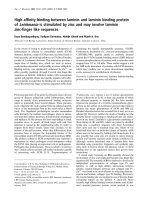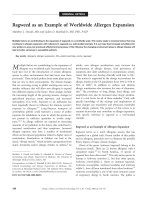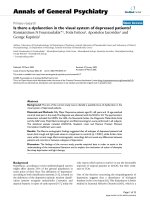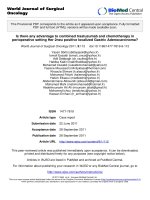Báo cáo y học: "Is there an association between anti-TNF monoclonal antibody therapy in rheumatoid arthritis and risk of malignancy and serious infection" ppt
Bạn đang xem bản rút gọn của tài liệu. Xem và tải ngay bản đầy đủ của tài liệu tại đây (37.97 KB, 3 trang )
Page 1 of 3
(page number not for citation purposes)
Available online />Abstract
A recent meta-analysis of randomized clinical trials reported by
Bongartz and coworkers raised concerns about an increased rate
of malignancy and serious infection in rheumatoid arthritis patients
treated with anti-tumour necrosis factor monoclonal antibodies.
This commentary discusses some of the methodological issues in
their analysis and urges caution in interpreting the results.
Introduction
The introduction of anti-tumour necrosis factor (TNF) agents
and their widespread use, particularly for treating rheumatoid
arthritis (RA), is based on favourable results from large-scale
randomized clinical trials (RCTs). The trial data were rightly
also utilized to investigate possible hazards associated with
the use of these drugs, and the results have mostly been
reassuring. The problem is that all of these trials are
individually too small and of insufficient duration to provide
useful data on rare but serious long-term hazards. In addition,
RCTs are typically conducted in lower risk patients (i.e. those
patients with significant current or recent co-morbidity are
excluded).
One approach to overcome the small size of individual
studies is to undertake a pooled or meta-analysis of all
relevant trials. Although this is indeed a frequently used
approach to derive robust estimates of efficacy, the data
gathered in trials on potential long-term hazards are not
routinely subjected to similar pooled analysis. In an attempt to
overcome the small number problem to examine serious
hazards from using RCT data, Bongartz and coworkers [1]
conducted a meta-analysis of the incidence of infections and
cancer occurring in the different treatment arms of the
published anti-TNF monoclonal antibody trials.
Summary of methods and findings
The meta-analysis identified nine trials of the use of infliximab
or adalimumab in RA. The authors did not include trials of
etanercept because they argue that the biological activity of
this receptor fusion protein is too different from that of the
monoclonal antibodies, specifically with regard to the relation-
ship to infection and tumour growth. The means of ascertain-
ment of serious adverse events were not identical to those
used in the original published trials, because the authors took
additional steps both to verify the nature of the events and to
include events that occurred during the – presumed open
label – period of follow up. They did not attempt to calculate
incidence rates (e.g. per 1000 person-years of exposure),
given the difficulty in ascertaining the exposure periods;
however, they calculated odds ratios (ORs), assuming
equality of follow up between the participants randomized to
the different arms within each of the individual trials.
Their results suggest a threefold (OR 3.3, 95% confidence
interval [CI] 1.2-9.1) increased risk for malignancy in anti-
TNF-treated patients compared with those in the standard
treatment arms of the included trials. This risk was
concentrated in those on high-dose therapy defined as
≥6 mg/kg infliximab over 8 weeks or (assumed but unclear in
the report) ≥40 mg adalimumab every other week, who had
an OR of 4.3 (95% CI 1.6-11.8). There was no important
increased risk below these levels. Many malignancies in the
anti-TNF arms of the trials were nonmelanoma skin cancers
(9/35), and a further four were identified within 6 weeks of
starting therapy. Even excluding these cases, the increased
risk compared with the comparison arms was still present,
especially because there was only such one cancer in the
comparison arms. The risk for serious infections was also
raised but to a more modest extent. Thus, there was an
Commentary
Is there an association between anti-TNF monoclonal antibody
therapy in rheumatoid arthritis and risk of malignancy and
serious infection? Commentary on the meta-analysis by
Bongartz
et al
.
Will Dixon and Alan Silman
Epidemiology Unit, University of Manchester Medical School, Manchester, UK
Corresponding author: Will Dixon,
Published: 11 August 2006 Arthritis Research & Therapy 2006, 8:111 (doi:10.1186/ar2026)
This article is online at />© 2006 BioMed Central Ltd
CI = confidence interval; OR = odds ratio; RA = rheumatoid arthritis; RCT = randomized clinical trial; TNF = tumour necrosis factor.
Page 2 of 3
(page number not for citation purposes)
Arthritis Research & Therapy Vol 8 No 5 Dixon and Silman
overall increase of twofold (OR 2.0, 95% CI 1.3-3.1) but with
a much less marked influence of dose. Therefore, these data
overall raise concerns about the safety of anti-TNF
monoclonal antibody therapy in RA, especially when used at
high doses.
Commentary
However, there are a number of areas in which caution is
required. First, the external validity of the findings to current
therapeutic practice should be considered. As stated above,
they did not include etanercept, which, for example, is the
most popular used anti-TNF agent in the UK. Indeed, as the
authors argue based on biological principles, this agent may
not be expected to carry the same risk. Second, the dose of
infliximab in standard RA regimens is typically 3 mg/kg; in the
trials evaluated there was only one malignancy (a lymphoma)
in a patient treated with this dose of infliximab.
Third, and of greater concern, is the malignancy rate in the
control arms, which was unexpectedly low. Among 1512
comparison arm patients, followed for what would appear to
be an average of 34 weeks, there was only one malignancy,
excluding the two basal cell carcinomas. In a typical RA
population, or indeed a general population sample of this age
group, one might expect an incidence of around 8/1000 per
year, which is at least eight times that seen in the comparison
arm patients and is of the same order of magnitude as that
seen in the anti-TNF arms of the trials. Does the threefold
increased risk reflect an unexpectedly low rate of cancer in
the placebo arms rather than a genuine increased risk from
anti-TNF therapy? It is not clear why the rate should have
been so low. If low-risk patient selection were a factor, then
this should have operated equally in the anti-TNF group.
There is, however, a possible explanation based on the
differential dropout between the studies following entry into
the trials. Typically, all patients entered into these explanatory
RCTs are, to varying extents, screened to exclude pre-existing
malignancy, for example with chest radiography. Thus, in such
patients there is a ‘telescoping’ of ascertainment of
malignancy before study entry, with the consequence that
fewer new malignancies will be identified in the early post-trial
entry period. As the authors acknowledge, in their meta-
analysis four out of the nine trials had a higher dropout in the
placebo arms, meaning that more patients withdrew from
follow up sooner. Given the reduced risk (as outlined above)
during the early follow-up periods, this would lead to a bias
toward detection of malignancy in the anti-TNF arms during
the later periods of follow up. Although all malignancies could
have been captured by the US Food and Drug Administration
beyond the end of the trial, it is less likely that the placebo
arm patients will have their malignancies spontaneously
reported once they enter the unblinded phase.
Of the 26 malignancies in the anti-TNF arms, 10 were
lymphomas. The possibility that such therapy might increase
lymphoma risk was raised previously [2], although it has been
difficult to disentangle the risk from the therapy from the
increased risk in patients with severe RA [3,4]. Indeed, it has
been argued that by reducing inflammatory activity, anti-TNF
agents might have the ability to reduce lymphoma risk [5]. It is
perhaps also surprising there were no lymphomas in the
comparison patients, given the previously reported increased
risk, especially in those with severe disease treated
conventionally [6]. However, using randomized trials, the
confounding effect of severity should have been allowed for,
and so these data do raise concerns about an increased risk
for this tumour that will require longer term follow up of much
larger cohorts.
The risk for infection was less marked than that for
malignancy in the analysis. Serious infections after
randomization might be assumed to be solely due to a drug
effect. However, serious infection is based on hospitalization
or intravenous antibiotic use, and the threshold for these
interventions might differ both between trials and between
treatment arms within a trial; if an individual has a good
response to the drug, then there may be a lower threshold for
admission to hospital with infection. Thus, in comparison with
malignancy, it is much harder to standardize the recording of
infections across the different trials. There were 35 serious
infections/1000 treated anti-TNF patients, which equates to
around 52/1000 person-years (or less, allowing for loss to
follow up). It is reassuring in terms of external validity that this
rate is broadly similar to those reported by two recent
national register studies from Germany (infliximab rate
62/1000 person-years) [7] and the UK (infliximab 55/1000
person-years, adalimumab 52/1000 person-years) [8].
Conclusion
Individual clinical trials are clearly too small, too selected in
the populations studied, and of too short a duration to
generate robust estimates of any possible increased risk for
rare adverse events. A meta-analysis, such as that conducted
by Bongartz and coworkers [1], has the ability to overcome
some of these issues and has raised the concern of a
potentially serious increased risk for malignancy. However,
the interpretation of the results needs to take into account the
unexpected and unexplained low risk in the comparison arms.
Further answers to these key questions of drug safety will
have to await the data rapidly accruing from large national
registers of unselected anti-TNF treated patients with the
appropriate comparison groups.
Competing interests
WD is the Clinical Research Fellow and AS is joint principle
investigator (with Professor Deborah Symmons) of the British
Society for Rheumatology Biologics Register (BSRBR). The
goals of the BSRBR are primarily related to examining the
long-term safety of biologic agents used in rheumatology. The
BSRBR is funded by a grant to the University of Manchester
from the BSR, which in turn receives funding from the
manufacturers of the agents licensed for use in the UK. The
Page 3 of 3
(page number not for citation purposes)
principal investigators have the normal academic freedoms to
exploit and publish the data accruing from the BSRBR, with
the approval of the BSR.
References
1. Bongartz T, Sutton AJ, Sweeting MJ, Buchan I, Matteson EL,
Montori V: Anti-TNF antibody therapy in rheumatoid arthritis
and the risk of serious infections and malignancies: system-
atic review and meta-analysis of rare harmful effects in ran-
domized controlled trials. JAMA 2006, 295:2275-2285.
2. Brown SL, Greene MH, Gershon SK, Edwards ET, Braun MM:
Tumor necrosis factor antagonist therapy and lymphoma
development: twenty-six cases reported to the Food and Drug
Administration. Arthritis Rheum 2002, 46:3151-3158.
3. Wolfe F, Michaud K: Lymphoma in rheumatoid arthritis: the
effect of methotrexate and anti-tumor necrosis factor therapy
in 18,572 patients. Arthritis Rheum 2004, 50:1740-1751.
4. Askling J, Fored CM, Baecklund E, Brandt L, Backlin C, Ekbom A,
Sundstrom C, Bertilsson L, Coster L, Geborek P, et al.:
Haematopoietic malignancies in rheumatoid arthritis: lym-
phoma risk and characteristics after exposure to tumour
necrosis factor antagonists. Ann Rheum Dis 2005, 64:1414-
1420.
5. Symmons DP, Silman AJ: Anti-tumor necrosis factor alpha
therapy and the risk of lymphoma in rheumatoid arthritis: no
clear answer. Arthritis Rheum 2004, 50:1703-1706.
6. Baecklund E, Iliadou A, Askling J, Ekbom A, Backlin C, Granath F,
Catrina AI, Rosenquist R, Feltelius N, Sundstrom C, et al.: Associ-
ation of chronic inflammation, not its treatment, with
increased lymphoma risk in rheumatoid arthritis. Arthritis
Rheum 2006, 54:692-701.
7. Listing J, Strangfeld A, Kary S, Rau R, von Hinueber U, Stoyanova-
Scholz M, Gromnica-Ihle E, Antoni C, Herzer P, Kekow J, et al.:
Infections in patients with rheumatoid arthritis treated with
biologic agents. Arthritis Rheum 2005, 52:3403-3412.
8. Dixon WG, Watson K, Lunt M, Hyrich KL, British Society for
Rheumatology Biologics Register Control Centre Consortium,
Silman AJ, Symmons DPM, on behalf of the British Society for
Rheumatology Biologics Register: Serious infection rates,
including site-specific and bacterial intracellular infection
rates, in rheumatoid arthritis patients treated with anti-TNF
αα
therapy: Results from the British Society for Rheumatology
Biologics Register (BSRBR). Arthritis Rheum 2006, 54:2368-
2376.
Available online />









